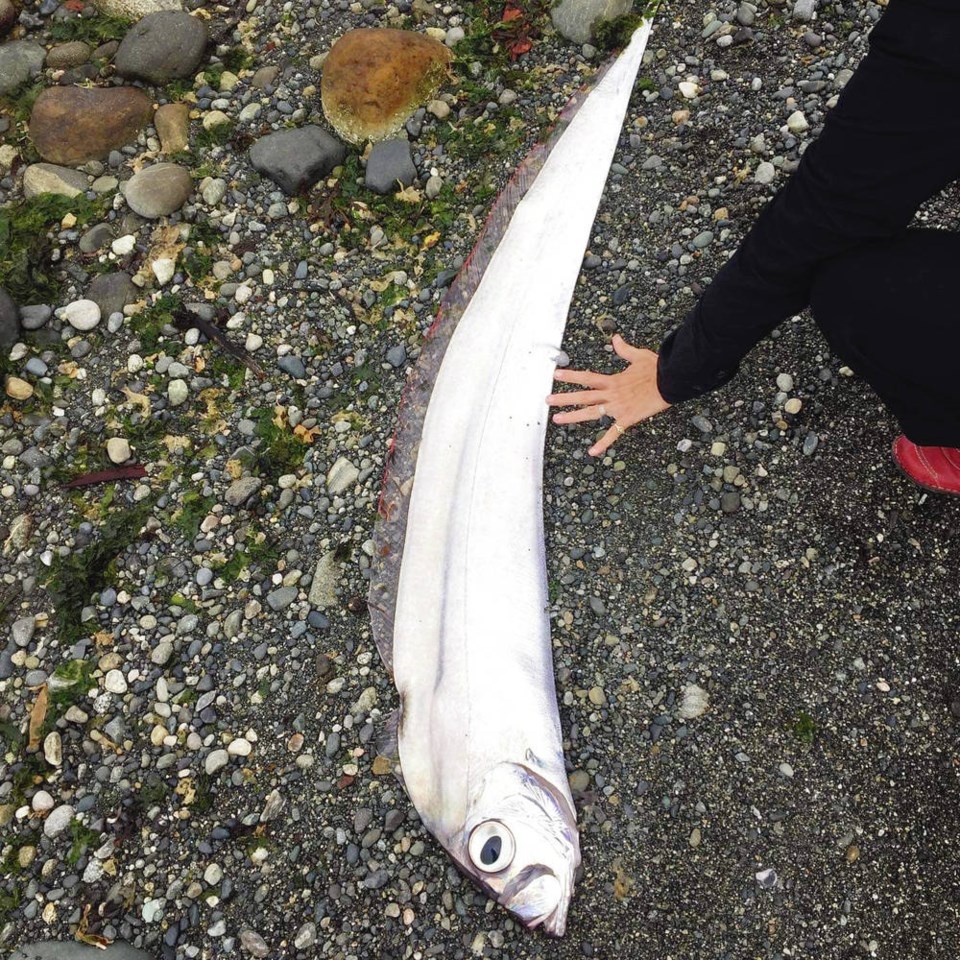Dana LeCompte was out for a family walk Friday at Whiffen Spit in Sooke when something shiny caught her eye.
“We thought it was a piece of metal, a piece of a shipwreck or something,” said LeCompte.
Daughter Sadie Liptrot, 15, and LeCompte’s sister, Karen who was visiting from Vancouver, were in for surprise.
They had stumbled upon a rare fish find.
It was a king-of-the-salmon (Trachipterus altivelis), a deep-sea-dwelling species of ribbonfish. Its common name comes from the legends of the Makah people west of Strait of Juan de Fuca, which believe this “king” leads the salmon to their spawning grounds each year.
The fish found about halfway along Whiffen Spit, was about 1.5 metres long, razor-thin and in perfect condition, so LeCompte believes it had only recently washed ashore.
“It was something to see,” said LeCompte. “It’s hard to see from the photo but it had this red line [the length of its dorsal fin, which goes from head to tail.]
She said the large eyes indicated “it must have been a fish that lives in very deep water.”
Since sharing the photo on social media, LeCompte has had hundreds of views and shares. She and her husband, Bob Liptrot, who own the Tugwell Creek Farm and Winery in the Sooke area, were able to identify the fish from Liptrot’s copy of Saltwater Fish of British Columbia.
King-of-the-salmon are deep-water fish ranging from Chile to Alaska that normally live in the open ocean at depths up to 900 metres, and are rarely seen until they end up in a net or occasionally wash ashore.
Only a handful of cases are documented, and most have been recent and on the South Island.
According to Marine Detective, a blog documenting sea creatures by Port McNeill biologist Jackie Hildering, two of the fish have been discovered in Oak Bay — on Sept. 21, 2017, and another five days later. A third was found on a beach off Hood Canal, Washington on Oct. 3, 2017. A fourth was found near Sidney on Oct. 2, 2017, about 100 metres north of Reay Creek.
The timing suggests the First Nation legend of the fish is accurate as salmon begin massing for spawns into rivers this time of year.
There have also been more recent cases of the fish being discovered on shore. According to Marine Detective, a 1.5-metre fish was found ashore on June 8 in Salt Creek, west of Port Angeles, Washington. Harbor WildWatch concluded it swam too close to shore and was killed by waves, saying “these thin, delicate fish are adapted for the deep ocean,” moving in snake-like fashion by undulating their bodies.
Greg and Kim Ashton also reported a juvenile king-of-the-salmon in shallows in Telegraph Cove on Aug. 19.
Other documented cases include a find by Darren and Joanne Rowsell near Port McNeill in 2012.
Scientists believe smaller king-of-the-salmon feed closer to shore and their diet is known to include copepods, annelid worms, fish scales and fish larvae. Larger king-of-the-salmon can reach 1.85 metres and feed on copepods, krill, small pelagic fish, young rockfish, squid and octopus.
Part of what makes the species unique is that they can capture and eat prey by a protrusion of the upper jaw.
LeCompte said in hindsight she should have preserved the fish she found on Whiffen Spit for researchers. She was told by a friend who had seen her social media posts and went back to search the site that the fish was gone, likely taken away by the tide.



